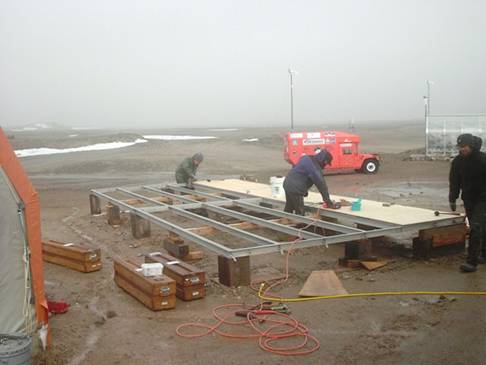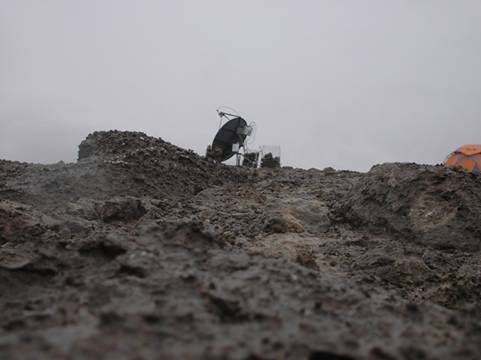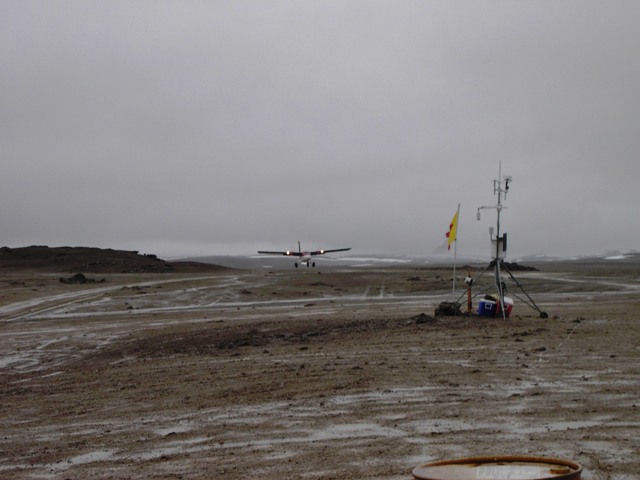HMP e-Logbook
As the field season progressed, the MIT team recorded and posted daily a record of their activities, along with a few selected photos.
The field site's logbook has been duplicated here.
July: 8 10 11 12 14 15 16 17 18 19 20 21 22 23 24 25 26 27 28 29 30 31 August: 1 2 3 4-6
July 12, 2005
Written by Olivier de Weck
This is the fifth day of our expedition and the second full day at camp for Oli and Erica. Unfortunately the weather got worse with winds of 20-25 knots, temperatures around 2-3 deg C and a light but persistent rain. This is not the dry polar desert we had expected. It turns out that the gear we brought (tents, sleeping bags, etc…) is not ideally suited for these conditions and we ended up being cold and damp for most of the day and night. Next time we will have to bring much more rugged gear. The high Arctic is a very demanding environment even during the peak of the summer. Equipment gets bumped around, dirty, muddy and wet very quickly. Even inside, laptops get dripped on from the condensation inside the tents. Electrical equipment gets shorted out very easily.
Oli helped AC. Hitch, John Schutt and Gordon Osinski ("Oz") set up the rest of the MIT tent frame. This required a short ride on the ATVs to a river bed about 1 km away to get some gravel. The drive was beautiful, but somewhat challenging having to constantly shift gears on the ATV. The gravel was used to build up a foundation for the tent. On top of the gravel one puts plywood for floatation and on top of the plywood come wooden blocks. Because the MIT tent is on a slight slope of about 10 degrees, each wooden block has to be cut to size quite precisely and then shimmed. I am amazed how long it takes to get the frame lined up, square and level. I am also impressed by the level of detail and professionalism by AC, John and the others in getting the frame set up correctly. Even half an inch of offset is unacceptable to them and they work consistently and methodically, despite the adverse conditions.

Erica spent the morning continuing the food inventory from the previous day. There was a lot of readjusting and modifications needed for the inventory template. The original template was not complete enough and new attributes were needed. Examples of things that were updated were different units of measurements (food is labeled in kg, grams, ml, oz, fl oz, etc……), different locations (different tents/modules). A major challenge is how to keep track of the cases (boxes, ballets, coolers) in which things are. This is a real headache but needs to be tracked carefully if one wants to find things. This problem also applies to ISS and planetary exploration. We decided that each item would be logged in the inventory with the Case ID in which it resides. A case itself is also considered a supply item and can also be inside another case. This way we can keep track of situations where an item is in a box, which is in a box, which is in a box etc…. with a relatively simple system. One just needs to track the "parent-child" relationships properly.
Erica also received the electronic inventory from the Canadian Space Agency (CSA) greenhouse equipment. This included items that were left at the end of the 2004 field season as well as new items brought in for the 2005 field season. Also, the CSA medical team shared their inventory. They brought with them relatively sophisticated equipment to conduct telemedicine experiments. The idea is that we will consolidate the inventories of all the equipment that is on-site into a master relational database.
There were many challenges throughout the day and especially the SFU communications team could not get the two-way C-band satellite connection established. The downlink worked, but the uplink was not seen by the CRC ground station despite the fact that the parabolic antenna dish (Fig. 2) was pointed correctly. There must be a problem with one of the power amplifiers or connectors and at the end of the day we still had not satellite communications and communications with Resolute had to continue via (noisy) shortwave radio. We are hoping for internet connection by the end of the week.

We also conducted a fuel inventory of all fuels present on base. It is surprising how many different types of fuel are present on base: diesel for the generators and the incinerator, automotive gasoline ("mogas") for the ATV's, aviation fuel (Jet B) for the Twin Otters in case of emergency resupply of the aircraft, propane for heating and cooking as well as stove oil for cooking during overnight EVA's. In addition there are large drums full of urine that has to be shipped back to Resolute for proper disposal.
Around 4:00p.m. it was announced that a flight would be arriving in 7 minutes. To our great surpise and pleasure this flight carried Matt and Mike who had been waiting patiently in Resolute for 2 days. It was challenging for them because they had many stop-and-go's and had to be ready at all times. The pilots made an amazing landing despite low ceilings, poor visibility and a wet runway (Fig. 3)

The MIT team was finally unified and we all helped set up Matt and Mike's tents in the rain. After a short briefing and excellent dinner (pork chops) we decided on the next days activities, watched a movie in the mess tent (From The Earth to the Moon – Parts 1 and 2) and settled into our tents around 10 pm for another windy and unsettled night.

